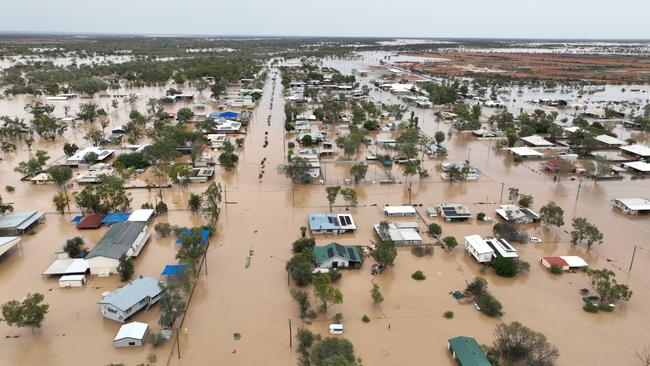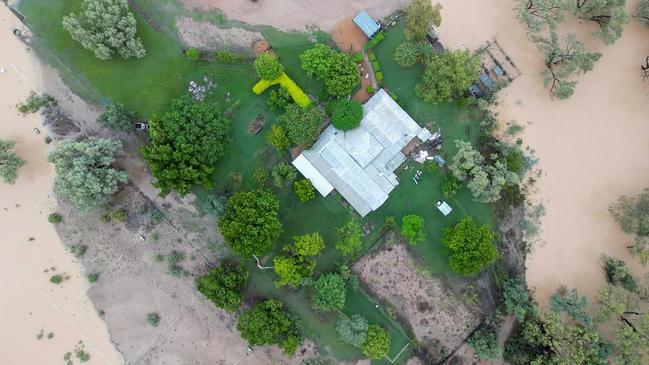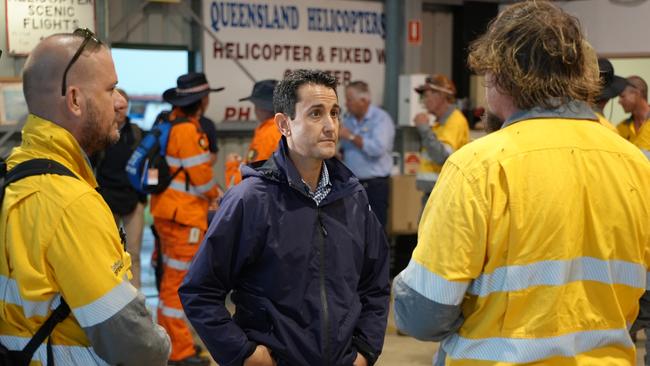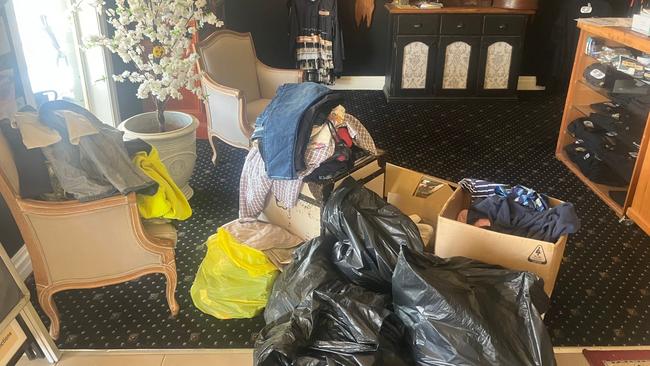Flood of the century unleashes heartache and destruction across the outback
Outback Queensland’s flood of the century has descended into a human and financial disaster for far-flung communities, beef stations and vast sheep runs as stock losses pile up and emergency services scramble to save people from the rising waters.

Outback Queensland’s flood of the century has descended into a human and financial disaster for far-flung communities, beef stations and vast sheep runs as stock losses pile up and emergency services scramble to save people from the rising waters.
Fabled western rivers including the Barcoo, Thomson and Cooper are at historic peaks, inundating more than 500,000sq km of grazing land in an emergency that reaches from Windorah in the Channel Country to Longreach in central west Queensland.
The floods have surpassed those of 1974, a benchmark in the remote region, and threaten to cost billions of dollars for primary producers who were battling drought only a week ago.
More than 150,000 head of cattle, sheep, horses and other livestock are feared to have perished, Premier David Crisafulli warned. This could drive up meat prices by 10 per cent nationally.
The personal toll was being counted on Wednesday as survivors recounted hair-raising rescues from homesteads and properties engulfed by the torrent.
Anne-Maree Lloyd and husband Geoff, a fourth-generation grazier, waded through hip-deep water to be extricated by chopper after the 153-year-old farmhouse at Jedburgh Station was swallowed in the dead of night by a raging Barcoo River. The building had never before been flooded.
“At about 4am Geoff came in and said, ‘I think we need to move’,” said Ms Lloyd, 62. “The water was starting to bubble through the floorboards and by the time the helicopter got there was nowhere for him to land that wasn’t under.”
Eventually the pilot put the machine down in the property’s sand-lined horse arena. “He could sit there, just briefly, while we waded out to him,” she said. “We were worried, yes. We had never seen water like it.”

On Wednesday, another drama played out near Tambo, 840km northwest of Brisbane, when a 31-year-old man inadvertently drove into a flooded creek with a loaded horse float. The four-wheel-drive was swept off the road. The driver, whom police stressed had been unable to see the danger in pre-dawn darkness, climbed on to the roof of the semi-submerged vehicle and was saved by a swiftwater rescue team of SES volunteers. The stricken horse was also led to safety.
Locals said they had no inkling of the volume of rain that was to be dumped on outer southwest Queensland by the remnants of Cyclone Dianne, which crossed the West Australian coast near Derby last Saturday.
The drumbeat on the roof of Jedburgh Station, an hour’s drive outside the township of Yaraka, was initially welcomed by Ms Lloyd, bringing relief from a dry and punishing summer. But the couple’s optimism turned to concern when the deluge persisted.

“The rain just went on and on, like nothing we’ve experienced,” she said. “Our house is right on the river, but we’re on a sort of island and we’ve never had a problem. Looking at the levels outside, we’ve had at least 1m go through it, so I don’t know what we’ll find when we get back in.”
“We know how to prepare for floods,” Ms Lloyd continued. “For 30 years, we’ve put our vehicles on high ground. This time, they all went under as well. Geoff estimates the flood was 2m higher than anything we’ve seen before.”
Mr Crisafulli said the number of lost livestock, scattered across a usually arid area twice the size of Victoria, was set to increase on the 70,000 cattle, 70,000 sheep and 10,000 goats and horses so far feared drowned or dead from exposure. With beef prices strong, graziers say prime cattle are worth up to $3500 a head.
“You’re dealing with a couple of million beasts in the broader area, so we expect that number to continue to rise,” he said.
The infrastructure damage included a recently completed $92m exclusion fencing project, which would have to be rebuilt to contain wild dogs. More than 7000km of private fencing was likely to have been destroyed, the state Department of Primary Industries said.

AgForce Queensland president Shane McCarthy said it was too early to put a figure on the full cost of the flood. Producers would have to replace or repair “machinery, sheds, houses, water infrastructure, as in troughs and poly-pipe … we work on a pretty tight budget as it is, and there wasn’t a great season out there to start with in most places. Any stock loss is going to be felt.”
Cattle Australia chair Garry Edwards said consumers nationwide could expect to pay up to 10 per cent more for meat. “The flooding is going to negatively impact supply, which will drive up prices nationally,” he said. “It’s hard to estimate this early on, but I would imagine a price increase between 5-10 per cent. And that increase won’t normalise for another six months at least.”
Quilpie mayor Ben Hall said primary producers would hit an “economic cliff”, with some facing the loss of entire herds. “People are potentially going to go three years without income,” he said.

At the Brick Hotel in Quilpie, population 450, publicans Brenda Murphy and Wayne McKenzie have taken in a dozen evacuees from the nearby township of Adavale since they were forced out last Thursday.
It was what people in the bush did for each other when times were tough. “At the start, everyone was in shock, which would be expected,” said Ms Murphy, 56.
“We just looked after them, anyone that came in. Some of them needed clothes. They got what they could from the op-shop here, and my son, my partner, and I all brought clothes for them. We put a post out on Facebook, and people just came with clothes.”
Bureau of Meteorology senior forecaster Dean Narramore said further flooding was on the cards, as rain continued to tumble out of the low-pressure weather system.
“We’ve got every river in southwest Queensland at major flooding now, and we’ll see further rises and prolonged flooding,” he said. “There is so much water already in those catchments that major flooding will continue for more than a month, even if no more rain falls.”




To join the conversation, please log in. Don't have an account? Register
Join the conversation, you are commenting as Logout